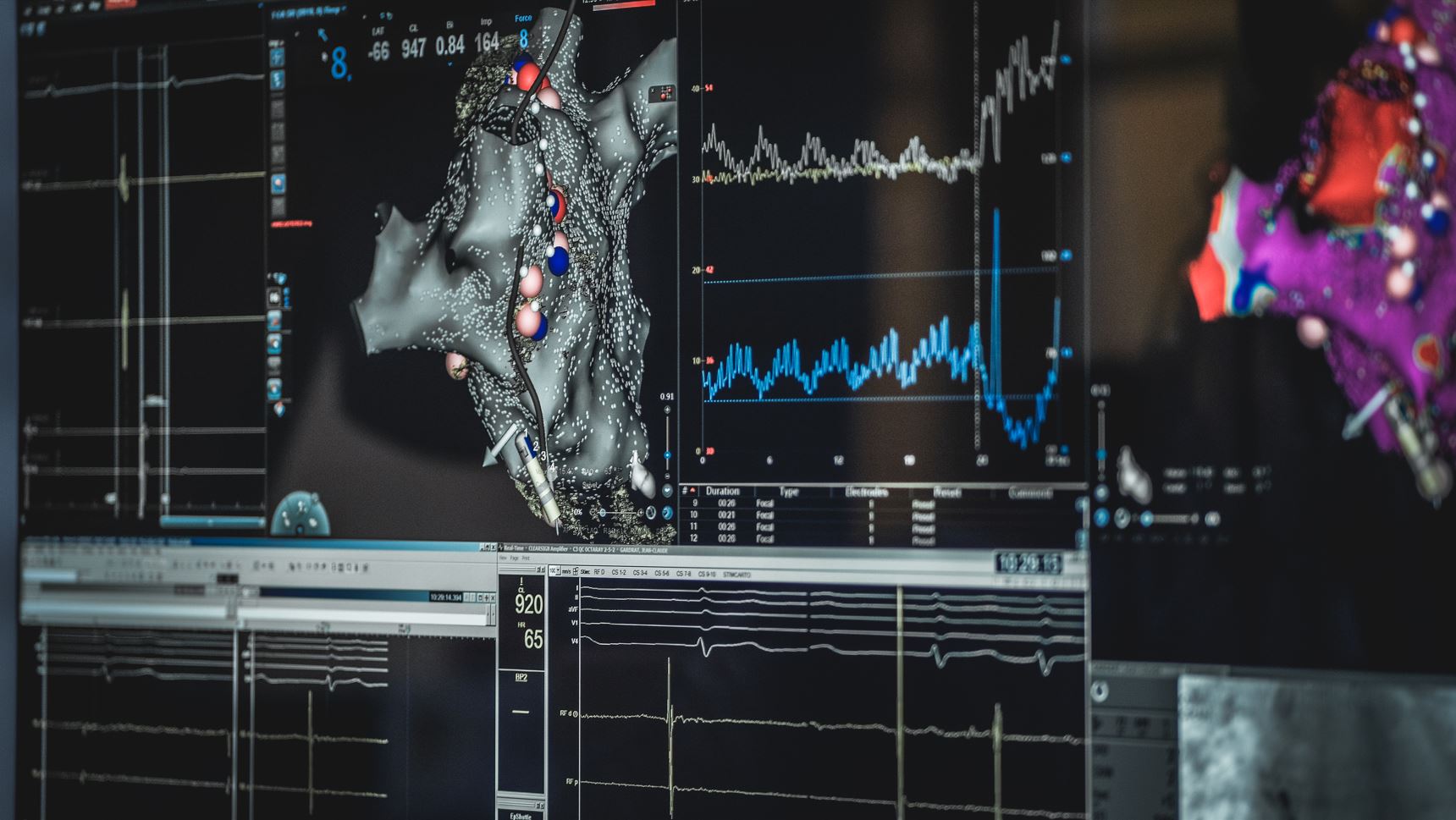Major strategic research projects

Thanks to its multidisciplinary approach, combining cardiac electrophysiology, high-resolution mapping, mathematics and modelling, the institute is able to conduct ambitious research projects in cardiac rhythmology, supported by prestigious national and international institutions.
Research projects on atrial fibrillation

BEAT AF
Revolutionary method based on electroporation for the treatment of atrial fibrillation (AF).
The multi-centre randomized BEAT AF study brings together nine European clinical centres to demonstrate that pulsed electric field catheter ablation (electroporation) is more effective, safer and faster than radiofrequency, the reference treatment to date for patients with AF. It will make it possible to reduce the recurrences that remain frequent and will be without damage to the collateral structures. Learn more.
This project has received funding from the European Union’s Horizon 2020 research and innovation programme under grant agreement no. 945125.
Project leader: Prof. Pierre Jaïs

PERSONALIZEAF
Personalized therapies for atrial fibrillation. A translational approach.
PersonalizeAF aims to provide an innovative, multinational, multisectoral and multidisciplinary research and training program in the field of new technologies, as well as innovative strategies for the individualized characterization of the substrate of atrial fibrillation and the increase in the effectiveness of treatments.
This project has received funding from the European Union’s Horizon 2020 research and innovation programme under grant agreement no. 860974.
Project leader: Nejib Zemzemi

ELECTRO
Exchange protein directly activated by cAMP-1 inhibition to prevent atrial fibrillation.
Among the known mechanisms involved in atrial fibrillation, the cAMP-binding protein Epac1 has recently emerged as a promising candidate. The ELECTRO project aims to determine the therapeutic potential of pharmacological inhibition of Epac1 in relevant models of atrial fibrillation, as well as the associated mechanisms.
Project leader: Fabien Brette

UNMASC
Understanding remodelling mechanisms during the evolution of atrial fibrillation for the development of better treatments.
The project aims to clarify the molecular, cellular and tissue remodelling processes responsible for atrial fibrillation so as to improve its treatment.
Project leader: Prof. Pierre Jaïs

DAWN-AF
Digital twins to treat atrial fibrillation.
The DAWN-AF project aims to develop a personalized medicine approach based on computer modelling for the ablation of atrial fibrillation to prevent recurrences. Physiological digital twins of patient hearts are created from imaging (magnetic resonance imaging/computed tomography) and calibrated using machine learning to analyse and adjust electrocardiogram recordings and clinically acquired electrograms, from implantable devices or wearable devices.
Research projects on fibrillation, ventricular tachycardia and sudden cardiac death

DIELECTRIC
Rapid electroporation and digital twin ablation of ventricular tachycardia.
Dielectric aims to combine two major advances, image integration and electroporation, to revolutionize the ablation of ventricular tachycardia. The scientific aims are: (1) To better characterize electroporation lesions in post-myocardial infarction scar tissue; (2) To develop a mathematical model to optimize and personalize electroporation delivery in scar tissue and to include it in a personalized imaging-based digital twin (MUSIC software); (3) Approve the approach through in vivo pre-clinical experiments; (4) Obtain a clinical proof of concept.
Project leader: Prof. Pierre Jaïs

HELP
A unique, non-invasive heart rhythm mapping system to identify subjects at risk for sudden arrhythmic death.
This project will set a new paradigm in clinical cardiac investigations and enable a major breakthrough in the prevention of arrhythmia deaths worldwide. The ability to detect and influence cardiac electrical signals will also have a considerable impact on the management of other cardiac pathologies, allowing earlier diagnosis of heart disease and better referral to drug, interventional or preventive therapies.
This project has received funding from the European Union’s Horizon Europe research and innovation programme under grant agreement N° 101054717.
Project leader: Prof. Michel Haïssaguerre

MAP IN HEART
CT scan targets for effective guidance of catheter ablation in ventricular tachycardia.
This project aims to develop a new 3D image-processing technology (map in heart) that would enable cardiologists to locate ventricular tachycardia ablation targets and guide ablation procedures in a non-invasive and very precise way.
This project has received funding from the European Union’s Horizon 2020 research and innovation programme under grant agreement no. 899539.
Project leader: Hubert Cochet

MAESTRO
Magnetic detection of arrhythmogenic ventricular substrate.
The MAESTRO project aims to evaluate an array of ultra-sensitive magnetometers on models of pathological and in-vivo hearts, thereby developing a non-invasive method for identifying signals associated with a high risk of sudden death.
Project leader: Prof. Michel Haïssaguerre

MEGAVOLT
Mechano-electrical coupling in the infundibulum of the healthy right ventricle and in pressure overload.
The right ventricular infundibulum is one of the main anatomical origins of ventricular arrhythmias and sudden death. Myocardial stretch could be an important regulator, causing arrhythmias in the right ventricle. The MEGaVOLT project investigates the contribution of this acute and chronic stretch in right ventricular outflow obstruction to identify the mechanisms associated with chronic infundibulum stretch.
Project leader: David Benoist

MULTIFIB
Multimodal fibre optic probe for highly resolved localization of cardiac fibrosis.
One of the main causes of sudden cardiac death is ventricular fibrillation, which results from structural heart disease. The MultiFib consortium develops and approves a new fibre optic probe for diagnostic and therapeutic purposes to enable the morphological and biochemical characterization of arrhythmogenic substrates in cardiac tissues.
Project leader: Richard Walton

RHYTHM network
Repolarization heterogeneity for personalized cardiac arrhythmia therapy.
The main aims of this project are to use a detailed understanding of the mechanism of sudden cardiac death to identify patients at risk of sudden death and to develop new individualized therapies in prevention mode.
This project has received funding from the “Fondation Leducq” as part of the “Transatlantic Networks of Excellence Program” (Research Agreement No. 16 CVD 02).
Project leader: Prof. Michel Haïssaguerre

SYNATRA
3D characterization of the cardiac conduction system with the ihMT (inhomogeneous magnetization transfer) magnetic resonance imaging technique.
The heart has an electrical conduction network called the Purkinje network that drives cardiac contraction, which may play a role in ventricular fibrillation. The SYNATRA project aims to develop an innovative technique to characterize, for the first time, the Purkinje network by contrast in 3D magnetic resonance imaging (MRI), using high-resolution ultra-high-field inhomogeneous magnetization transfer.
Project leader: Julie Magat

TUNE
Non-invasive tools to better understand sudden death in structurally normal hearts.
The aims of this project are to develop and approve a non-invasive tool capable of identifying arrhythmogenic electrical substrates in patients whose hearts are structurally normal.
Project leader: Laura Bear

V-SMART
Arrhythmogenesis through the ventricular scar.
The aim of this project is to elucidate the role of electromechanical (EM) effects on arrhythmogenesis through scarring in the ventricles. A combination of biological experiments and computer simulations will be performed. Biological experiments will demonstrate the mechanisms, as well as provide detailed scar geometry and functional parameterization. Using this new physiological knowledge, personalized patient EM cardiac models will be created and potential therapies will be investigated in silico.
Project leader: Edward Vigmond
Transversal projects

ECSTATIC
Electrostructural tomography – Towards a multiparametric imaging of cardiac electrical disorders.
The aim of this European Research Council (ERC) project is to advance knowledge in the characterization of heart rhythm disorders, thereby creating new diagnostic and treatment tools through the development of a new non-invasive modality (electrostructural tomography), combining magnetic resonance and non-invasive cardiac mapping.
This project has received funding from the “European Research Council” under the ‘Horizon 2020’ programme: EU research and innovation program from 2014 to 2020: ERC-2016-STG, (Research agreement no. 715093).
Project leader: Hubert Cochet

INEURHEALTH
Artificial intelligence, digital twin and clinical trial for breakthrough catheter ablation technology.
The startup inHeart has developed a system that makes it possible to create 3D images of detailed anatomy, as well as the sources of arrhythmias.
This system enables cardiologists to guide their ablation catheter in real-time. The goal of the project is to conduct a clinical trial to highlight a gain in efficiency and also from an economic point of view.
Project leader: Maxime Sermesant

MICROCARD
Digital modelling of cardiac electrophysiology at the cellular scale.
The MICROCARD project aims to advance cardiac modelling. Its goal is to develop a sophisticated and powerful platform, enabling the creation of digital models of cardiac activity at cellular resolution, which do not yet exist.
Project leader: Mark Potse

SICVALVES
Multi-scale modelling of valvular heart disease – understanding the mechanisms of adverse remodelling to improve precision medicine.
The incidence of valvular heart disease in ageing populations represents a real public health problem. The main aim of the project is to develop and approve computer models to study the mechanisms responsible for the disease and to help clinicians better plan therapies.
Project leader: Jason Bayer

SIMCARDIOTEST
This project aims to design new tools for predicting cardiac pathologies. It brings together 10 international partners who will develop a standardized and secure platform where virtual clinical trials can be carried out to test drugs and medical devices.
Project leader: Yves Coudière

CARCOI
MRI – High-resolution CARdiac thermometry on a clinical scanner using intracardiac COILS.
This project aims to develop original magnetic resonance imaging (MRI) instrumentation and real-time image acquisition/processing methods to monitor temperature during the treatment of cardiac arrhythmias by radiofrequency catheterization. It is a major step forward in improving the quality of cardiac MRI.
Project leader: Bruno Quesson

EQUIPEX MUSIC
Multi-modal exploration platform in cardiology.
Through this project, MUSIC, a multimodal exploration tool has been created, combining the various existing technologies in the study of cardiac electrical disorders, so as to allow a multiparametric evaluation of pathologies and treatment guidance on a single platform.
MUSIC is used in an international consortium, for therapeutic purposes, in more than 20 international hospitals since 2017. This work has benefited from state aid managed by the National Research Agency under the program “Investments for the future” bearing the reference “ANR-11-EQPX-0030.”
Project leader: Prof. Pierre Jaïs

HEARTFACT
Dark blood magnetic resonance imaging (MRI) and artificial intelligence-based automated segmentation for highly detailed characterization of the myocardial scar.
The HEARTFACT project proposes the development of new 2D & 3D approaches to cardiac MRI, associated with automatic segmentation based on artificial intelligence to help distinguish blood from tissue. This will improve the diagnostic capabilities of cardiac MRI and transform the treatment of patients with cardiovascular diseases.
Project leader: Aurélien Bustin

NON-INVASIVE CARDIAC PACING WITH FOCUSED ULTRASOUND
This project aims to develop a non-invasive device for cardiac stimulation using extracorporeal focused ultrasound, thanks to a dedicated tool designed in collaboration with the regional company Image Guided Therapy. The project plans to have multiple clinical applications based on temporary cardiac stimulation.
Project leader: Bruno Quesson

ULTRASOUND
The use of ultrasound is a safe imaging modality, allowing real-time examination. Its use is limited by technical constraints. The aim of this project is to use ultrafast ultrasound (10,000 images/sec) to provide images of very rapid tissue movements, currently undetectable, and to offer new perspectives for medical diagnosis, making it possible to obtain increasingly precise, more quantitative and more functional images of the tissues.
Project leader: Prof. Michel Haïssaguerre